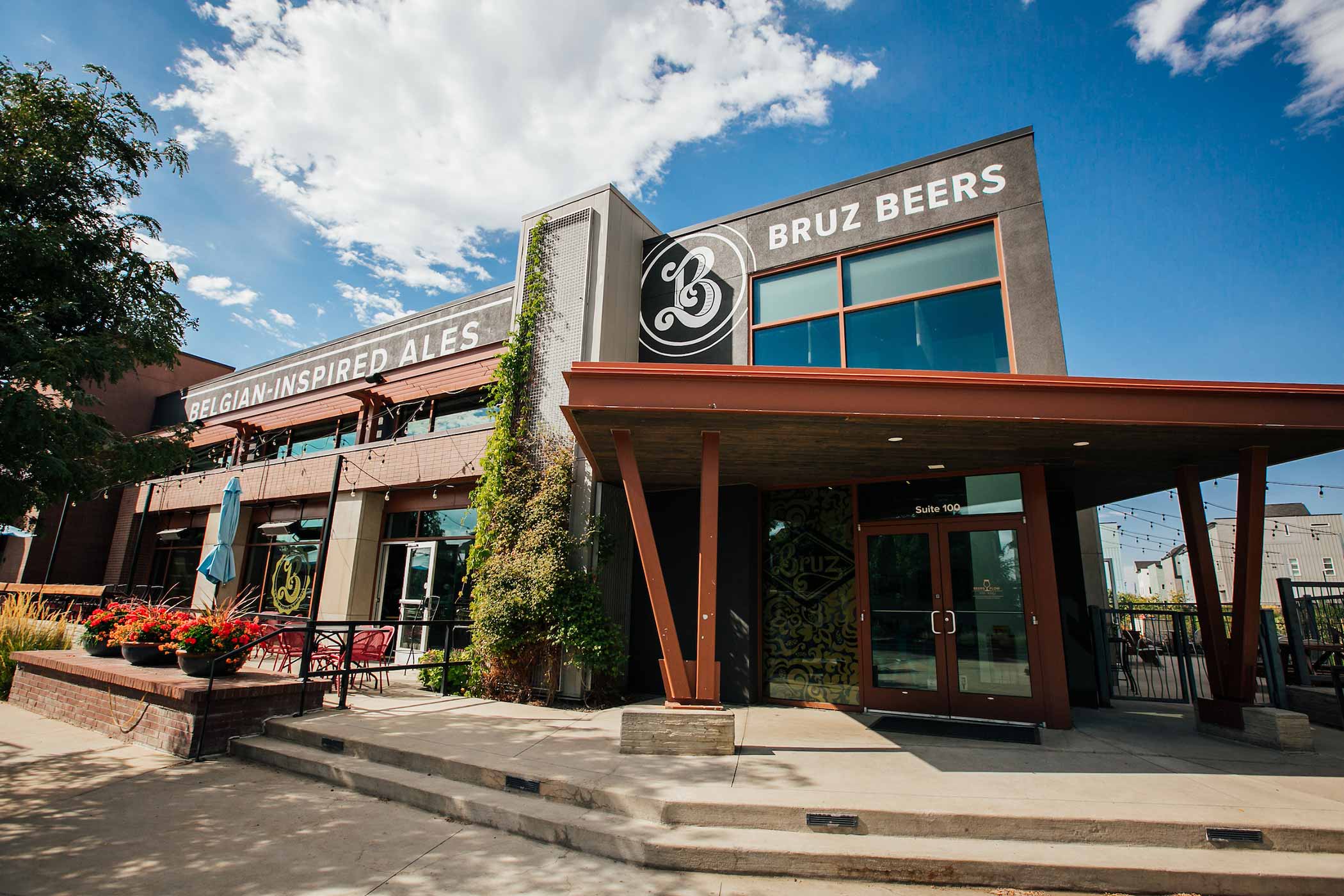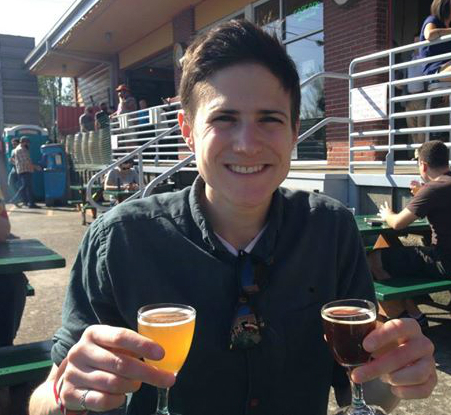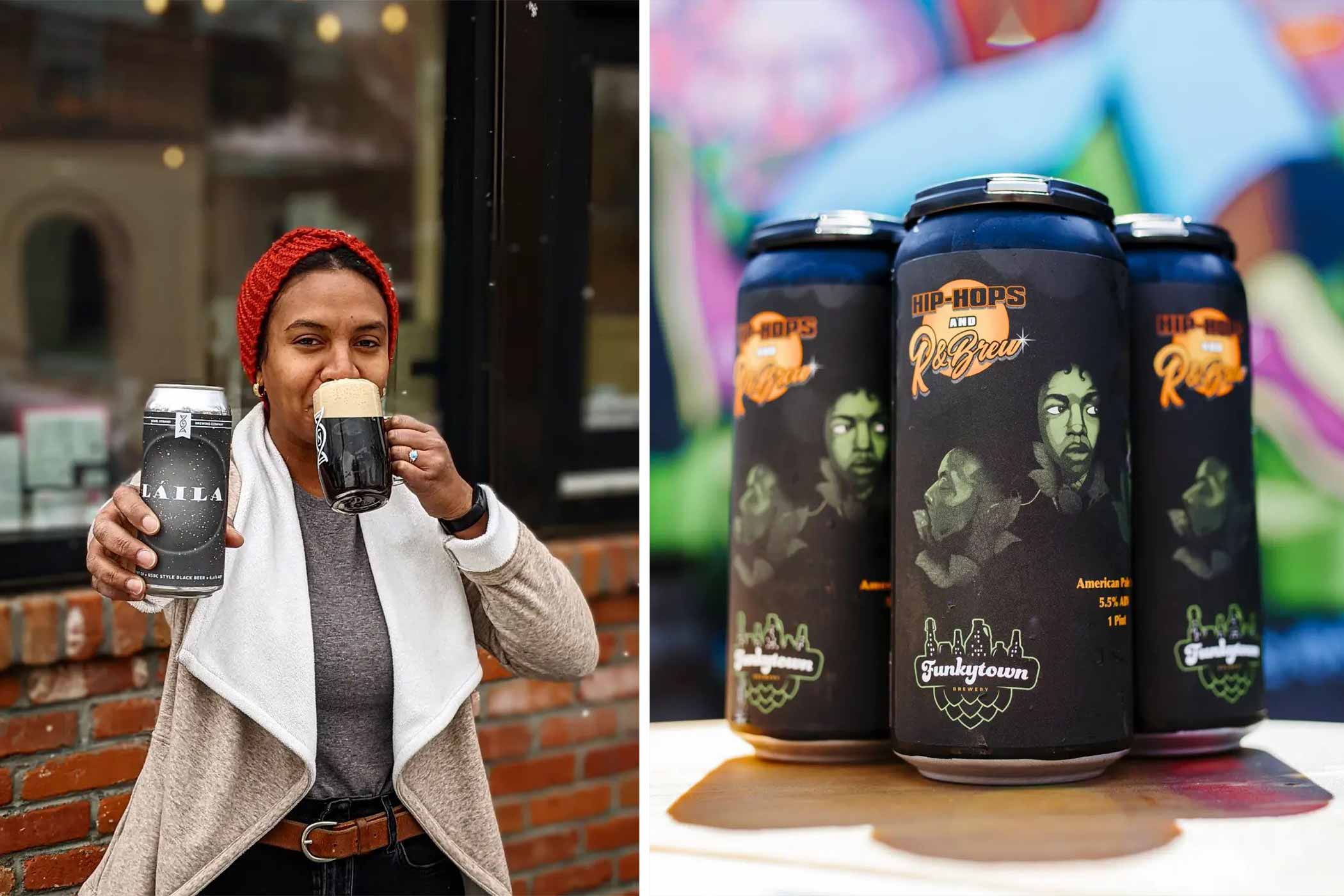Shop
Bruz Beers: Unapologetically Brewing Badass Belgian Beers
Visit Belgium without every leaving Denver.
What’s the one beer that changed your life?
Bruz Beers Co-Founder Ryan Evans fell in love with Belgian beers during a college backpacking trip in Europe. While making his way up to Amsterdam, Evans had a two-hour layover in Brussels. So he did what all good college students do: He found a pub.
“I walked in and said I’ll have a beer,” says Evans. “The bartender brought over a book, dropped it on the table, and walked away.”
Perusing through all the beers, Evans couldn’t find one he recognized. “The styles—dubbel, tripel, quad—I didn’t know any of it,” says Evans, who eventually just asked the bartender what to drink.
“He said Tripel Karameliet,” Evans reminisces. “I didn’t even know if he had just called me a bad word!” But when the glass came over, Evans took a sip he’ll never forget. “‘What is this?’” he questioned. “I never had anything like that in my life.”
Evans ended up staying for four or five more beers, walking crooked back to barely make his train.
That beer changed his life.
And now the beers he, co-founder Charlie Gottenkieny, and his crew make at the entirely Belgian-focused brewery Bruz Beers in Denver, CO, are changing the lives and palates of Americans.
Bringing Bruz Beers to Life
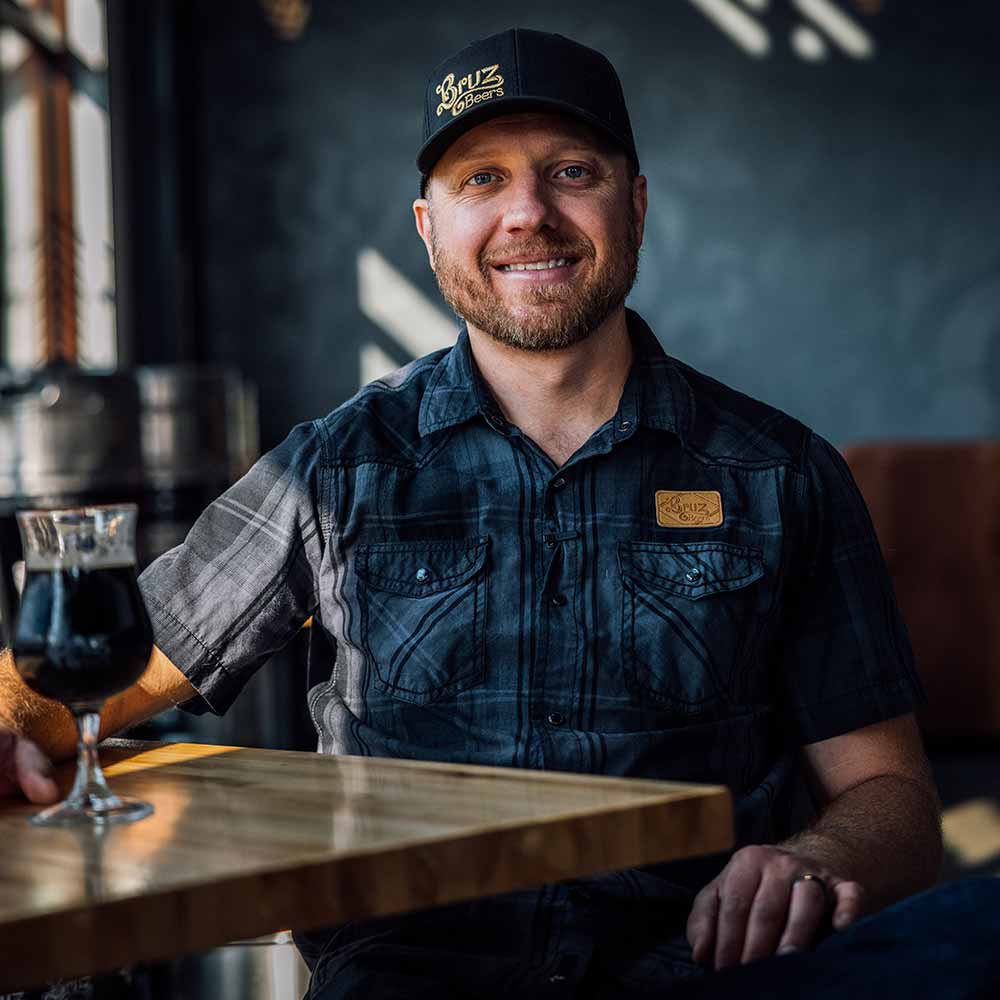
Photography courtesy of Traverse Image
For the rest of Evans’ time in Europe, he kept traveling back to Belgium, bringing more and more friends to places like Bruges or Ghent to share his reverential experience.
“I just fell in love,” says Evans. But coming home to the States, Evans couldn’t find any well-brewed Belgian beer.
A chance article in a paper his wife found highlighted Charlie Gottenkieny, who had spent twenty years traveling to Belgium, bringing home beers, and teaching himself to brew them. Evans attended a class Gottienkieny gave on Belgian beers. “Sure enough I tasted some of his beers he made himself and they were right on target with what I drank over there,” says Evans.
So he approached Gottenkieny with a business idea: to open a brewery in the States devoted entirely to making Belgian beers. “I didn’t know anything about opening a brewery, but this needed to get out there and people deserved [these beers] over here,” says Evans.
For three years, the duo worked on a business plan, searching for the right property and building everything out.
In 2016, Bruz Beers opened its doors, fighting a tide of disbelief and bleak assumptions.
Quite simply: People didn’t believe that a solely Belgian-focused brewery could survive in America.
Beating the Odds One Belgian Beer at a Time
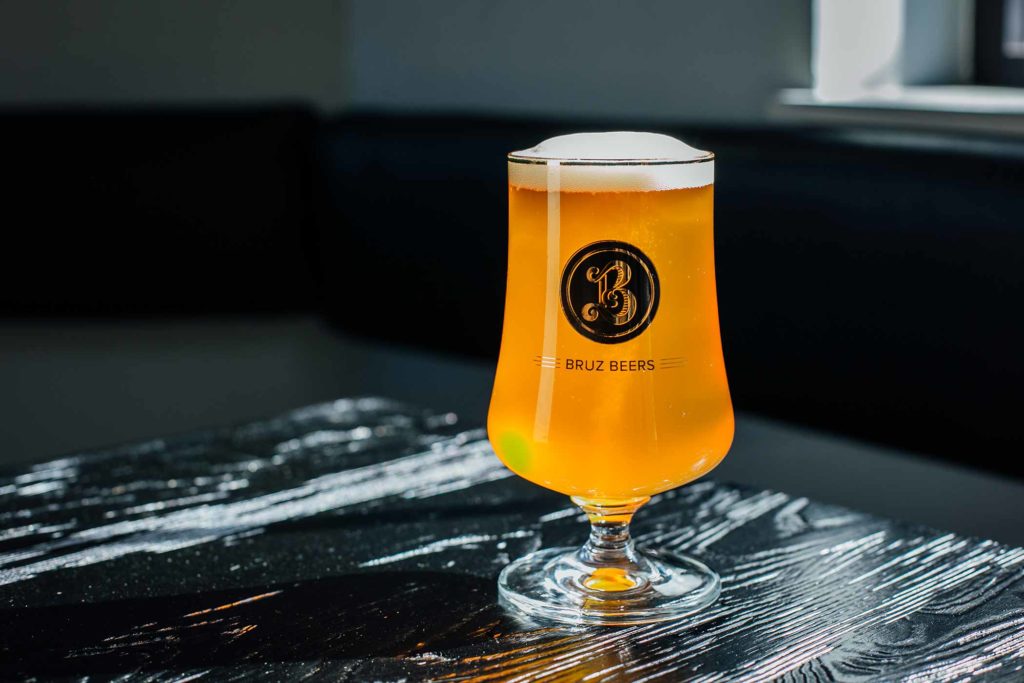
Photography courtesy of TruBlu Images
Here’s the thing about Belgian beer styles: Brewers have been perfecting them for hundreds if not thousands of years, literally.
The country of Belgium has an incredibly complex and robust beer history, punctuated by the tradition of monks or nuns brewing beer and selling it to raise money for their given monastery.
Considered trappist beers, these styles like dubbel, tripel, and quad emerged as early as the sixth century. In fact, breweries like La Grande Trappe are on record as operating as early as 1685.
Overall, Belgian styles take an incredible amount of time, care, and cost to execute well.
For instance, your average American brewery making hazies, IPAs, and other ales might expect to turn its tanks in two weeks. The average beer at Bruz takes double that, at the very least, and up to six weeks to over a year or more depending on the style.
“Their heads would explode if they came and watched our process,” laughs Evans, who had to buy twice as many tanks when opening the brewery, adding to the initial upfront investment.
Bruz Beers had to build around the idea that their beers would take longer, use up more space, and cost more. But ultimately, in the end they would be higher quality.
“Our upfront cost was more, but our caring cost on the beers is also more,” Evans says. “This is just what we do, we do it well, and we’re sticking with it.”
In some respects Bruz Beers’ business model is a complete 180 from how most American breweries operate.
“Some breweries look at each tank as needing to be turned as quickly as possible at two weeks max, that thing needs to hum and turn like a clock” says Evans. “Ours is the opposite of that; we have some tanks tied up for years and that’s unheard of.”
For that reason, it can be pretty rare to find a brewery in the U.S. dedicated entirely to brewing their own versions of Trappist beers, Belgian pale ales, or even lambic styles.
Editor’s Note: To be clear, that’s not to say they don’t exist. Brewery Ommegang in upstate New York is a great example and Primitive Beer in Longmont, CO, has excelled at the lambic style. But overall, a brewery focused just on Belgian styles can be hard to find.
But Bruz has unfailingly stuck to their truth and vision over the last six years despite the doubters.
“Everyone told me we couldn’t do it,” says Evan. “When we first started, people said we’re crazy, you can’t just do Belgian beers, you have to make something for everyone or you won’t get enough people in the door,” says Evans.
One hundred percent, you can taste the difference in Bruz’s beers. They’re not chasing trends or trying to make the juiciest hazy. They’re just one hundred percent committed to bringing high-quality Belgian beer styles to America.
Battling Bad Belgian Beer in America
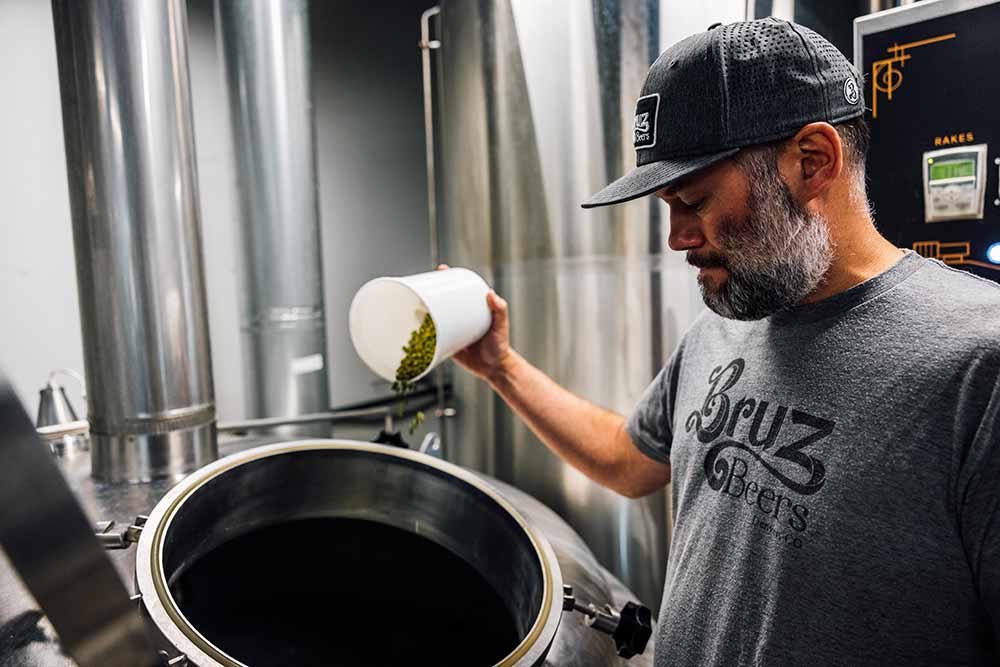
Photography courtesy of Traverse Image
Along with battling the cynics, Bruz Beers also had to overcome an American palate led astray, at least when it came to Belgian beers.
Whereas Trappist monks and nuns refined their brewing styles over centuries, unfortunately in America, brewing Belgian beers often meant cutting corners. Brewers simply didn’t want to dedicate the necessary time to execute a Belgian style.
And trust us, you can taste the difference.
“I think Belgian styles had a challenge here in America as breweries opening up in the ‘90s tried to cater to everyone, making stouts, lagers, and Belgian beers,” says Evans. “A brewery that’s ninety-five percent other styles that throws in a Belgian every once and a while can’t expect it to be off-the-wall good.”
For a lot of Americans, that meant drinking Belgian beers that weren’t true representations. Or just weren’t very good at all. Beers that were too sweet because they hadn’t been fermented long enough in the tanks or didn’t have good head retention and depth because the temperatures were off, for example.
Remember when we said Belgian beers take time to make? Brewers simply weren’t willing to take the time to perfect these styles.
Bruz Beers were.
“We just live, eat, and breathe [Belgian beers],” says Evans. “And we make it better every time; We always joke that we’re probably the luckiest people in the country because we don’t have to chase trends or wake up and try to figure out how to put glitter in our beer or what the next cereal is going to be—Lucky Charms or Frosted Flakes… If I want a doughnut I’ll go get a doughnut, but I don’t need it in my beer, right?”
In today’s market it can be a tough proposition for breweries to ambulance chase, if you will. “Watching people try to figure out what’s next to conquer and make theirs the best is a tough game,” says Evans. “You’re putting a lot of money, resources, time, and energy into something that may turn on you in six months.”
Whereas those breweries might feel pressure to crank out fifteen to twenty new styles every six months, Bruz is completely content to stay in their lean, tweaking their recipes to perfection.
Bruz just makes historically good beers. Free from chasing all the BS and dedicated to only Belgian styles, Bruz has been able to make some pretty amazing beers.
A Top-Notch Tripel
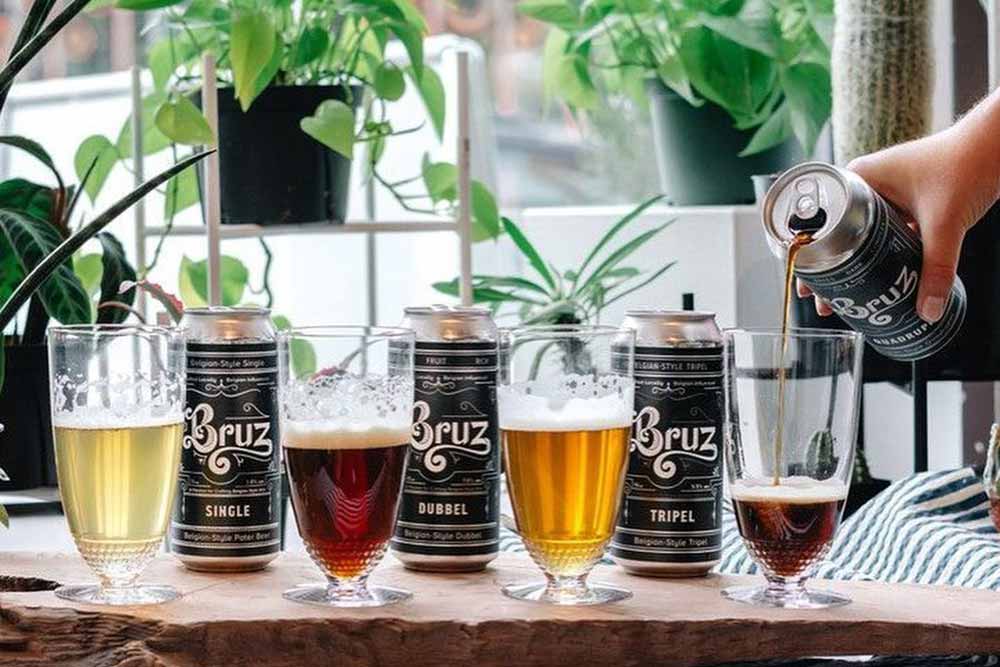
Photography courtesy of @infulldetail
For Evans it all starts with their tripel.
Afterall, it could be said that Tripel Karmeliet started this whole crazy journey for Bruz Beers.
“Brewers always make fun of me because you can’t just drink tripel. I think I could,” laughs Evans. “If I’m stuck on an island, the tripel would be my choice.”
So it goes without saying that Bruz needed to nail its own version. And here again time became key, with the team dialing in the recipe over five to six years, according to Evans.
But originally, the recipe started with Evans and his team buying and trying all the Belgian tripels they could. Oftentimes, Evans’ mom would be the team’s secret blind taste pourer. “We’d sit on her patio and she’d pour a bunch of tripels out for us,” says Evans, who notes that without any idea behind the brand they could only taste the tripel in a glass, removing all potentially partial influences. “We’d taste them one by one and make a list of attributes we liked and disliked.”
For example, the team liked the spice level, color, and creaminess on Tripel Karmeliet. They took what they loved across the board and kept tweaking the recipe. “It was never one specific recipe we were working towards,” says Evans. “We took the best in the world we could find and built the flavor profile from there.” With each batch they’d fiddle a little, using a higher temperature here or a longer boil there. Until eventually, Bruz Beers’ year-round tripel emerged as a rock-solid traditional abbey-style. According to Evans, it’s the recipe they worked the hardest on over the years.
And it shows.
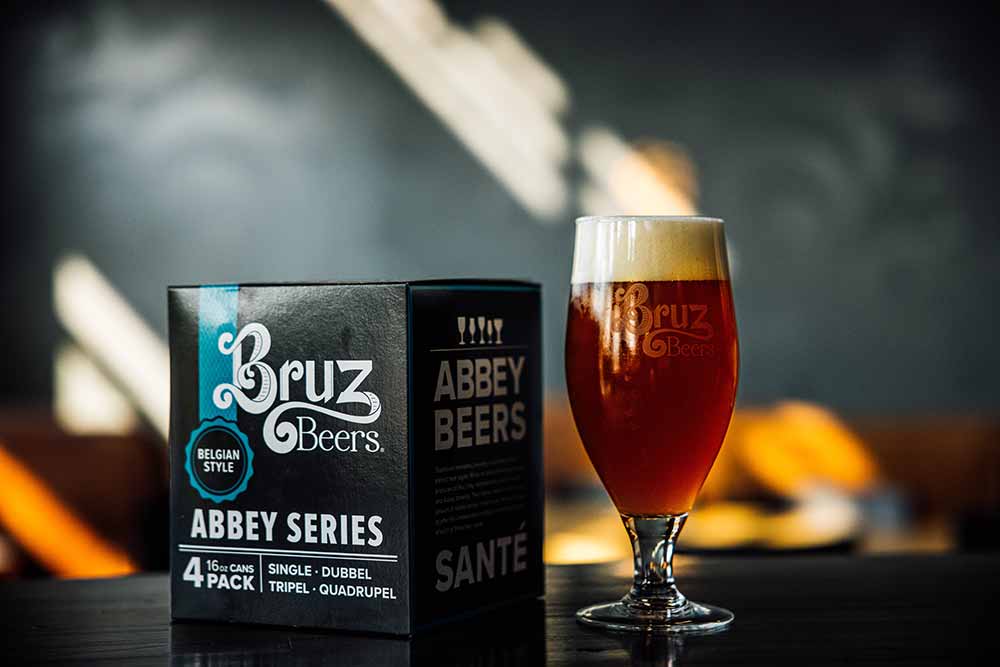
Photography courtesy of Traverse Image
A pale 9.5% Abbey-style with flavors of peaches, pears, and light spice, “It’s drinkable, it’s approachable, but a little dangerous,” laughs Evans. “I don’t know that it’s similar to anything else out there because we took an approach of the best attributes of all of them and combined them into one.”
It’s an approach Bruz has also used to craft its single, dubbel, and quads, among others.
And while you can find all the well-known styles like dubbel, tripel, quad, and witbiers on the tap list, don’t skip on checking out any bottles Bruz Beers might have available. That’s where you’ll find some truly funky gems.
Unapologetically Brewing Belgian Beers
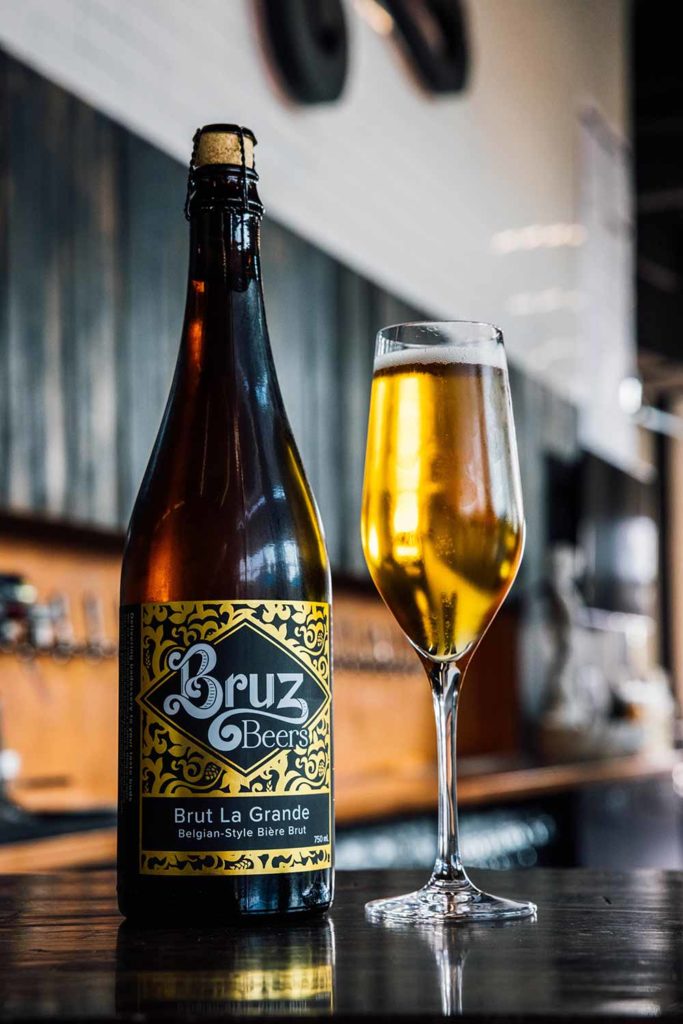
Photography courtesy of Traverse Image
Look, you’re not going to Bruz Beers to drink IPAs. Yes, they have a Belgian IPA that they’ve perfected, but it’s not the beer they’re most proud of.
“If you come in here and experience just that, you’ve really sold yourself short,” says Evans.
You’ll have missed out on one of Bruz’s usually four quads on tap in the winter.
Or their Dam Blanche, a super popular 5.5% ABV witbier with all-Colorado ingredients such as orange peel and coriander.
On the funkier side, you’ll find incredible jewels like Redwood Grand, a whiskey barrel-aged quad blended with a Flander sour ale from Belgian brewery Omer Vander Ghinste. It’s this crazy, funky, kind of smokey firework explosion in your mouth.
Or Brut La Grande, a beer fashioned off a Belgian style created in the ‘90s called Brut. Evans describes this type of beer as a light blonde ale that’s almost like a creamier, smoother tripel.
A nine-month process, brewing Brut La Grande is extremely labor intensive, tying up tanks, time, and energy.
Bruz uses three different yeasts and sugar additions over nine months, naturally bottle and keg conditioning Brut La Grande to perfection. “Other than riddling it down to the bone like a champagne,” this beer follows all the traditional techniques (but don’t worry, Evans says they’re working on getting this beer to follow the champagne style where one adds yeast to the neck, freezes it, pops it out, and corks it for next year).
The beer comes out once a year in time for Thanksgiving and usually sells out just after New Year’s, according to Evans.
Velvety smooth and creamy, Brut La Grande hits 12% ABV but drinks like a 4% ABV beer. “It’s very clean with notes of apple and pear and delicate on the tongue,” says Evans. “It has a lot of natural carbonation…so it kind of tingles and dances a bit.”
Order this beer on tap in the tasting room and it’ll come to you in a champagne flute on a platter with a piece of Belgian chocolate. “That’s the classiness of this beer,” says Evans.
Recently, Bruz released its Long Day Tripel. Evans says Bruz will actually release around ten tripels a year. This one in particular took about six to seven years to perfect. The beer follows essentially the same recipe for Bruz’s regular tripel, just increasing the boiling time…a lot.
Normally, for their flagship tripel, Evans says the boil lasts one-and-a-half hours. But for Long Day Tripel, that boil rolls for an incredible nine hours.
The added boil time scorches the sugars, creating a very dark but also complex tripel with layers of flavors and bodies. Oh, and it raises the ABV, of course, from 9.5% ABV to 12.5% ABV.
It’s just another example of how Bruz Beers does things a little bit differently, taking a little (or a lot more) time.
That’s Not the ‘Yeast’ of It
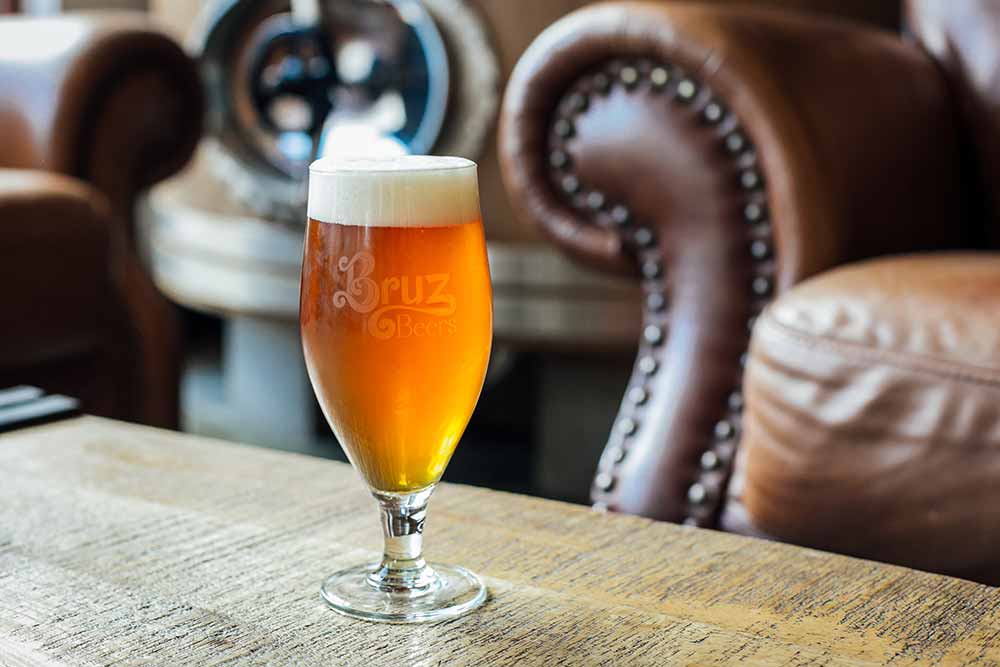
Photography courtesy of TruBlu Images
“Yeast is everything in a Belgian beer,” says Evans. It’s another area where Bruz flips a U-turn to the traditional American brewery model.
Whereas some breweries may only entertain around two to five different strains of yeast, Bruz uses fifty to sixty different yeast strains in a given year.
“I guarantee you we use more yeast strains than anyone in the whole region, not just in Colorado,” says Evans. Bruz gets its yeast propped locally from Propagate Lab and Inland Island Yeast, growing some of their own, creating blends, and even bringing others back from Belgium that these two suppliers keep on file for them.
Bruz goes deep on yeast because that’s the right way to do it. And if you have learned just one thing about Bruz so far, it’s that they brew with integrity, respecting the process and time it takes to make an elite Belgian-style beer.
Changing up the yeast in one particular Belgian style could mean shifting the entire color, for example. That’s how important yeast is to a Belgian beer. A bad batch of yeast would mean Bruz will dump the beer. “It’s expensive, but it’s the proper way to do it,” says Evans, who says the brewery will use multiple generations of yeast, even donating to other local breweries looking to brew a good one-off Belgian style. “Yeast is a big deal to us. Most people don’t understand how much yeast imparts a flavor into beer because they’re used to either malt or hops.”
But just as IPAs aren’t a true concern here, the hottest, trendiest hop isn’t either.
Just as it is in Belgium.
A Little Piece of Belgium in Denver
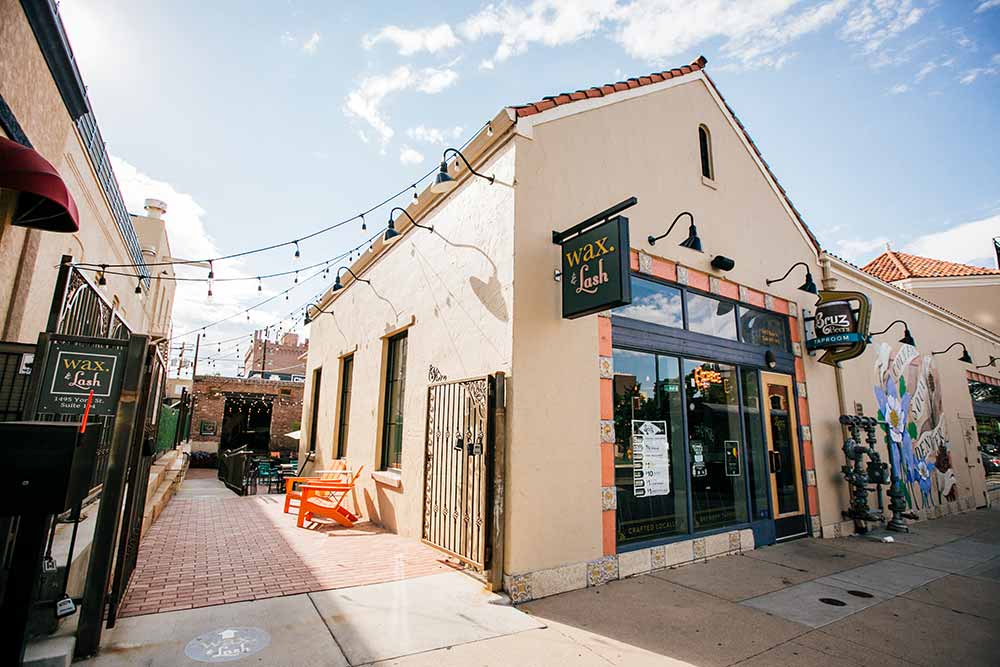
Photography courtesy of TruBlu Images
Bruz Beers isn’t just a brewery; it’s like stumbling through the back of the wardrobe. Only instead of ending up in Narnia, you hop across the pond to Belgium.
The original location in an original Northwest neighborhood of Denver called Midtown is a bit more family friendly and has a great space for events such as Belgian beer festivals (something Bruz has held in the past, inviting both traditional Belgian breweries such as Duvel and more modern American ones such as Ommegang to participate).
When Evans and Gottenkieny opened a second location in the much more bustling Capitol Hill neighborhood, this taproom attracted a bit of a younger crowd.
“Colfax [Street] is right there and it’s chaotic, busy, and then got this little oasis a hundred feet away,” says Evans. “You don’t even notice any of that. Just sit back here with trees, the music, and next thing you know you’re having a beer like you’re in Europe.”
Plus, Bruz embraces the brewery’s philosophy to bring a taste of Belgium to Colorado by offering educational classes almost every month. For instance, they’re World of Belgian Beers class walks people through fifteen different Belgian beer styles, offering samples, history, and flavor profiles. “We travel around Belgium while pouring beers and experience them together,” says Evans. “If you can’t afford the time and money to go to Belgium, come to the tasting room. We’ll give you the experience here.”
Regardless of which taproom you visit, Bruz Beers’ philosophy has slowly and surely resounded off the Front Range Rockies surrounding Denver, its echoes reverberating for almost seven years now.
“People drive two hours to come here,” says Evans. “They might be passing fifty other breweries on their way here, and that blows my mind.”
But they come because they know there is nowhere else in the state quite like Bruz. Nowhere else where they can try pitch-perfect Belgian beers in a place that idolizes these historical styles to the point of obsession, free from distracting trends.
Sticking to Their Belgian Beer Guns
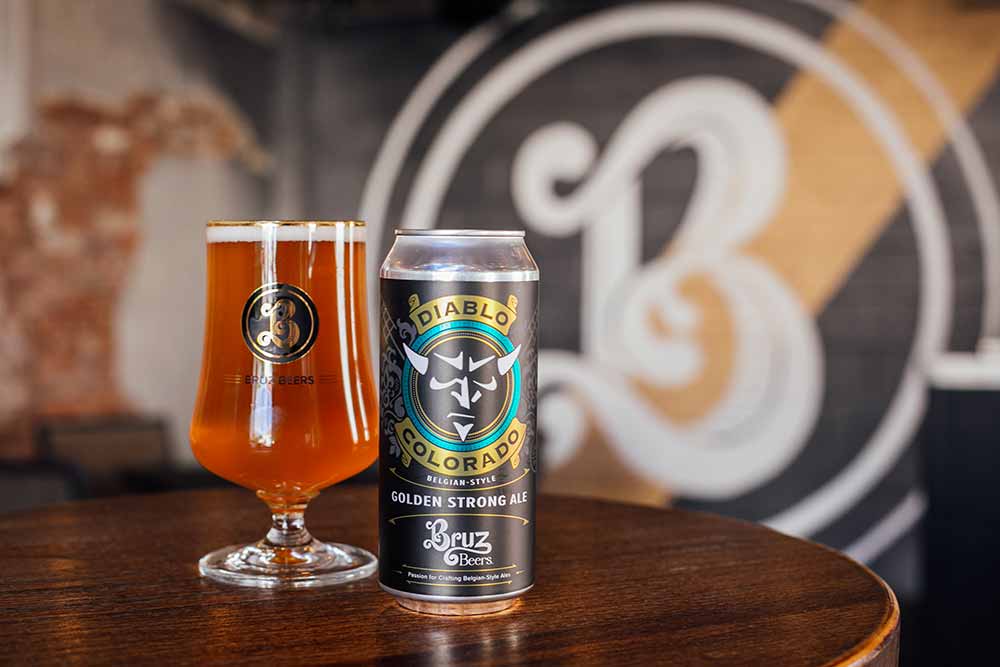
Photography courtesy of TruBlu Images
Interestingly enough, Evans believes it’s Bruz’s total commitment to their love of Belgian beers that has reaped benefits in the past and will continue to in the future.
“Obviously, IPAs are still king and hazy IPAs are hanging in there, but I also think that people’s tastes have shifted dramatically over the last seven years we’ve been in the business,” says Evans. “Our beers are really focused on good, clean, historical-style beers and we’re not chasing trendy additions… And now people just want a good, clean, quality beer.”
Evans mentions the contrast between the fickle tastes of American craft beer and other countries like German, the Czech Republic, and Belgium, which have stayed true to their brewing roots for centuries. “We like to follow trends and be on the leading edge…the roller coaster of what’s the next hottest trend,” he says. “Now, people are settling in and they just want a beer.”
Perhaps Evans is right.
Every year in December, Untappd puts together a culmination of stats from the entire year, including the top highest-rated styles. In 2022, for the first time, a couple Belgian-style beers made it into the top ten.
Traditional lambics landed in tenth with an overall style rating of 4.09 on Untappd while fruit lambics tied for seventh with an overall style rating of 4.1 on Untappd in 2022.
But really, either way, the statistics won’t shift Bruz’s approach. They’ve been sticking to their Belgian beer guns for almost seven years and absolutely nothing is going to change that.
They’ll never apologize for making badass Belgian beers. And they should never have to.
“We’re spoiled, we are absolutely spoiled,” says Evans. “The key is to keep doing what we’re doing… We’ve worked too hard and we’re having too much fun.”

